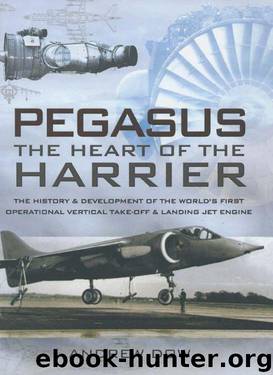Pegasus, The Heart of the Harrier: The History and Development of the World's First Operational Vertical Take-off and Landing Jet Engine by Andrew Dow

Author:Andrew Dow [Dow, Andrew]
Language: eng
Format: epub
ISBN: 9781473807488
Publisher: Pen and Sword
Published: 2009-08-20T07:00:00+00:00
Assuming that George Brown’s account of the conversation is accurate, it was clearly not the whole story. It could not be assumed that Bristol Siddeley had spare capacity, as in 1964 Bristol Siddeley had produced turnover of £76.5 million against Rolls-Royce’s £78.0 million while only having 75% of Rolls-Royce’s manpower.26
It is interesting to note at this point that the government held the following comparison, drawn in January 1965:
George Brown did not, apparently, ask Pearson what Rolls-Royce had done to look at greater sub-contracting, the expansion of its own facilities, or collaboration, any of which might have been cheaper than buying a rival. His answer was not what Pearson wanted: if Rolls-Royce was thereby to create a monopoly, the state would feel obliged to take a shareholding in Rolls-Royce to guard the taxpayers’ interests.
The discovery that Bristol Siddeley was about to enter a significant agreement with P&WA, with whom Rolls-Royce was not on good terms, provoked Rolls-Royce into a fresh look at Bristol Siddeley in the spring. On 4 June 1966 a press announcement was made that Rolls-Royce intended to buy Bristol Siddeley. At the time no formal consultation had been undertaken with the government, and this was duly arranged by officials. A briefing note of 12 July from the Ministry of Aviation concluded that no overriding reasons could be found for opposing the acquisition.27 The proposed deal is in fact referred to throughout official papers as a merger, probably because the officials concerned had the terms of the Monopolies and Mergers Act of 1965 in their minds.
The briefing note states interestingly, ‘A short time ago it appeared that two rival international aero-engine alignments were emerging, Pratt and Whitney/SNECMA and Rolls/General Electric/Man-Turbo.’28 And so, apparently, in Rolls-Royce’s mind, while a further alignment between General Electric and Rolls-Royce on the RB178 was acceptable, an alignment between Pratt & Whitney and Bristol Siddeley on the JT9D was not. Not only that, but another version of this brief, in the same file, states the view that Pratt & Whitney was using Bristol Siddeley ‘as a Trojan Horse’ to get into Europe. Lost in this whiff of hypocrisy was still the truth, to emerge later, that Rolls-Royce was not concerned about production capacity, nor P&WA’s incursions into Europe: all that Derby wanted to do was to stop the JT9D competing with its ambitions to supply RB178 or RB207 engines for the Airbus. Eventually Rolls-Royce abandoned the RB178 as having too many mechanical problems, it abandoned the RB207, and it abandoned the Airbus. Instead, it concentrated everything on getting a deal with Lockheed with the RB211. Whether or not Pratt & Whitney saw this as a threat in the same terms as Rolls-Royce saw Pratt & Whitney cannot now be said, but after many years of dominance of the Airbus market by General Electric, a consortium including P&WA and Rolls-Royce eventually won significant business with the Airbus.29
Rolls-Royce approached the government again, to be told in due course that a reference to the Monopolies and Mergers Commission would probably not take place.
Download
This site does not store any files on its server. We only index and link to content provided by other sites. Please contact the content providers to delete copyright contents if any and email us, we'll remove relevant links or contents immediately.
| Dollhouses | Dolls & Doll Clothing |
| Miniatures | Model Trains |
| Models | Stuffed Animals |
| Toymaking | Wood Toys |
On Writing A Memoir of the Craft by Stephen King(4221)
The Doodle Revolution by Sunni Brown(4051)
A Simplified Life by Emily Ley(3579)
Mummy Knew by Lisa James(3174)
Marijuana Grower's Handbook by Ed Rosenthal(3126)
Paper Parties by Erin Hung(3045)
Better Homes and Gardens New Cookbook by Better Homes & Gardens(2962)
Figure Drawing for Artists by Steve Huston(2804)
Draw Your Day by Samantha Dion Baker(2713)
The Genius of Japanese Carpentry by Azby Brown(2615)
Japanese Design by Patricia J. Graham(2562)
Lions and Lace by Meagan Mckinney(2496)
Dangerous Girls by Haas Abigail(2481)
The Curated Closet by Anuschka Rees(2392)
Zero to Make by David Lang(2349)
How to Make Your Own Soap by Sally Hornsey(2345)
The Wardrobe Wakeup by Lois Joy Johnson(2238)
The Code Book by Simon Singh(2217)
The Checklist Manifesto by Atul Gawande(2208)
